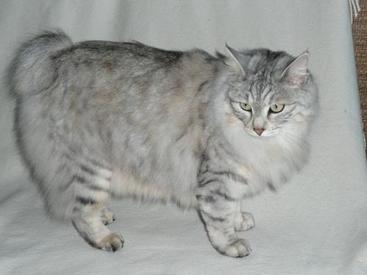
Otherwise known as the Curilsk or Kuril Bobtail, the breed is believed to have hailed from the Kuril Islands which are claimed by both Japan and Russia – 50 volcanic islands in a region of high seismic activity between the North Pacific and the Sea of Othotsk. These native cats are thought to have existed in the region for over 200 years, with some arriving in central Russia during the 20th century alongside scientists, militants and cat enthusiasts. The Kurilian Bobtail is greatly valued for its keen climbing and hunting abilities, being able to hunt vermin and larger animals, ready for the trailing hunter to retrieve. The Kurilian Bobtail is fairly rare, although it is much more numerous across Europe and its homeland Russia compared with the United States. The breed gained championship status from the International Cat Association in 2012.
The breed is described as ‘cobby’ with a medium to large body shape, a wedge-shaped head, a broad chest, slightly longer hind legs than front legs, and striking oval eyes. The Kurilian is further characterised by its wild appearance and unique bobtail; not only is the tail different from other cat breeds, it is unique to the individual cat. Various tail lengths and shapes are observed in the Kurilian, anything from kinks to spirals. Although yellow and green eyes are the preferred colour, eyes will usually correspond to the coat. Typically, the coat itself is without pointing and is most commonly seen in red or grey solid colours. Owners have described the Kurilian’s natural affinity with water, having traditionally been utilised alongside fishermen, helping to catch fish and retrieve nets.
Highly intelligent and trainable, the Kurilian Bobtail makes a great addition to family life, being relatively low-maintenance to care for. Whilst many enthusiasts think of the Kurilian as a sweet-natured, docile and affectionate lap-cat, it also possesses a playful, animated and inquisitive nature that demands attention. If your Kurilian is going to be housed indoors, make sure you provide a variety of interactive toys and playthings to keep your cat occupied and enriched throughout the day. Generally speaking, a healthy Kurilian Bobtail will weigh 8-15 pounds depending on its gender, with a typical life expectancy of 15-20 years.
Thought to be healthy, resilient and long-lived, there is very little information documenting genetic or breed-specific health conditions in the breed due to its rarity.
Do you own a Kurilian Bobtail? Let others know what they're like!
Related products
Advantage 80 Spot On Flea Control Large Cats and Rabbits
from £12.95
Advantage 40 Spot On Flea Control Cats, Small Dogs and Rabbits
from £12.95
Advantage 100 Spot On Flea Control Medium Dog
from £12.95
Advantage 250 Spot On Flea Control Large Dog
from £12.95
Drontal Tasty Bone Wormer Tablets for Small & Medium Dogs (2 to 20kg)
from £2.15
FRONTLINE Plus Flea & Tick Treatment Dogs & Cats
from £17.49
TermaWorm™ Tablets for Cats & Dogs
from £1.59
Drontal Tasty Bone XL Wormer Tablets for Large Dogs (Over 20kg)
from £6.39